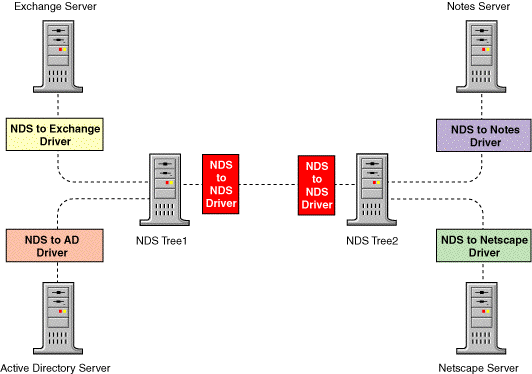1.4 DirXML and Multiple Directories
Most companies have anywhere from 20 to 200 directories, with the “average” company having 180. How many depends upon your network configuration, applications, and number of operating systems. In most companies, the telephone system, human resources, e-mail, and each operating system will have their own directories. Keeping user information current in all of them requires multiple administrators and data entry for each directory. DirXML is designed to eliminate such duplicate data entry.
For example, if your company first enters newly hired employees in a human resource database, the DirXML driver that connects that database to eDirectory can be configured to create new users in eDirectory and place them in the appropriate container in the tree based on the department that hired them. Then, when the employee moves to another department and to a different container, eDirectory sends these changes to DirXML which sends them to the human resource database. The change needs to be made in only one database, and the other database is automatically updated.
If multiple applications are using DirXML to synchronize with eDirectory, DirXML synchronizes shared data with all the applications. The following figure illustrates a configuration with six DirXML drivers.
Figure 1-3 Sample DirXML configuration with six drivers

Driver 1. The NDS to Exchange driver synchronizes data with eDirectory Tree1.
Driver 2. The NDS to NDS driver synchronizes data from eDirectory Tree1 to eDirectory Tree2.
Driver 3. The NDS to Active Directory driver synchronizes data with eDirectory Tree1, the NDS to NDS driver synchronizes the data to eDirectory Tree2, and the NDS to Exchange driver synchronizes it to Exchange.
Driver 4. The NDS to Notes driver synchronizes data with eDirectory Tree2.
Driver 5. The NDS to NDS driver synchronizes the data from eDirectory Tree2 to eDirectory Tree1, the NDS to Exchange driver synchronizes the data to Exchange, and the NDS to AD driver synchronizes it to Active Directory.
Driver 6. The NDS to Netscape driver synchronizes the data with eDirectory Tree2 and the NDS to Notes driver synchronizes it to Notes. The NDS to NDS driver synchronizes the data to eDirectory Tree1, the NDS to Exchange driver synchronizes the data to Exchange, and the NDS to AD driver synchronizes it to Active Directory
If a change occurs in one application, that change is propagated to the others. For example, if a user name is changed in the Netscape directory, the DirXML drivers propagate the change to the other five applications: Active Directory, eDirectory Tree1, eDirectory Tree2, Notes, and Exchange.